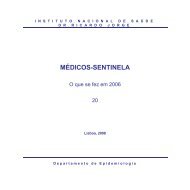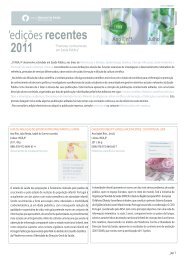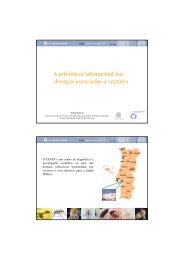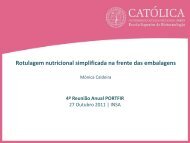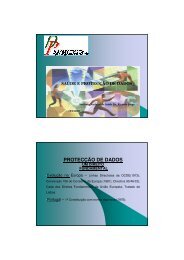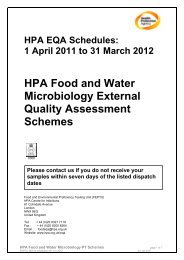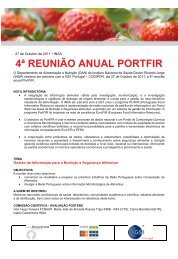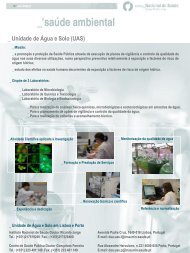European Society of Mycobacteriology - Instituto Nacional de Saúde ...
European Society of Mycobacteriology - Instituto Nacional de Saúde ...
European Society of Mycobacteriology - Instituto Nacional de Saúde ...
You also want an ePaper? Increase the reach of your titles
YUMPU automatically turns print PDFs into web optimized ePapers that Google loves.
PP-26<br />
AN INCREASE OF DRUG RESISTANCE SINCE 2001<br />
IN MULTIDRUGRESISTANT M. tuberculosis ISOLATES FROM BELGIUM<br />
Karolien St<strong>of</strong>fels, Maryse Fauville-Dufaux<br />
Reference Laboratory <strong>of</strong> Tuberculosis and Mycobacteria, Scientific Institute <strong>of</strong> Public Health, 642 Rue Engeland, 1180<br />
Brussels, Belgium. Tel. +32-23733210 | Fax. +32-23733281.<br />
kst<strong>of</strong>fels@iph.fgov.be, mfauville@iph.fgov.be<br />
Between January 1994 and December 2008, MDR clinical isolates <strong>of</strong> 174 patients were analyzed in our National Reference<br />
Laboratory. They represent 90% <strong>of</strong> all the MDR-TB patients i<strong>de</strong>ntified in Belgium during this 15-years period. Since 2000,<br />
the number <strong>of</strong> MDR patients i<strong>de</strong>ntified in our country is stable (in average 16 per year, i.e. an average <strong>of</strong> 1,3 % <strong>of</strong> the<br />
patients tested for susceptibility to drugs) but the isolates are resistant to more and more second line drugs. We observe<br />
a dramatically increase in resistance to ethambutol, rifabutin, amikacin and <strong>of</strong>loxacin, as well as to pyrazinamid.<br />
We divi<strong>de</strong>d the studied period in 2 ranges, 1994 to 2000 and 2001 to 2008. Only the first MDR clinical isolate <strong>of</strong> each patient<br />
was taken into account. So these results do not consi<strong>de</strong>r the evolution <strong>of</strong> the isolates during treatment in Belgium,<br />
but only the initial MDR resistance pr<strong>of</strong>ile.<br />
In the second period (2001 to 2008) 75,6% <strong>of</strong> the MDR clinical isolates showed resistance to ethambutol versus<br />
45,5% in the first period (increase <strong>of</strong> resistance <strong>of</strong> 30,1%); 75,4% were resistant to rifabutin versus 70,4% in the first<br />
period (increase <strong>of</strong> 5%). Resistance to pyrazinamid increased from 39,6% to 55,6% (difference <strong>of</strong> 16%). Resistance<br />
level to amikacin showed an increase <strong>of</strong> 12,2% (3,6% to 15,8%) and resistance level to <strong>of</strong>loxacin showed an increase<br />
<strong>of</strong> 8,6% (3,6% to 12,2%).<br />
No primary XDR isolate was observed during the first period, but 5 were <strong>de</strong>tected since 2001. Three MDR isolates <strong>de</strong>veloped<br />
into XDR what the total amount <strong>of</strong> XDR strains brought to 6 and only 2 for respectively the second and first period.<br />
Concerning the genetic families i<strong>de</strong>ntified, 14,7% more Beijing strains were registered in the second period compared to<br />
the first period. A <strong>de</strong>crease <strong>of</strong> the members <strong>of</strong> the LAM and Haarlem family was noted (16,4% and 17,3%).<br />
In conclusion, an important increase <strong>of</strong> resistance to ethambutol, pyrazinamid, amikacin and <strong>of</strong>loxacin is observed in MDR<br />
clinical isolates <strong>de</strong>tected in Belgium. This confirms the urgent need for new anti-tuberculosis drugs.<br />
98 ESM 2009



